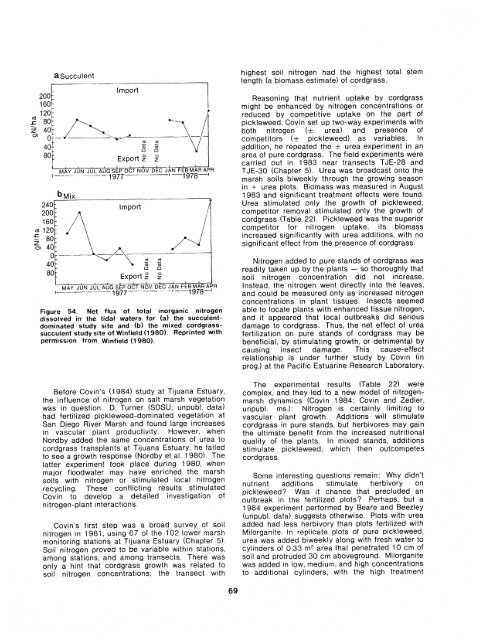The Ecology of Tijuana Estuary, California: An Estuarine Profile
The Ecology of Tijuana Estuary, California: An Estuarine Profile
The Ecology of Tijuana Estuary, California: An Estuarine Profile
Create successful ePaper yourself
Turn your PDF publications into a flip-book with our unique Google optimized e-Paper software.
Import<br />
Export<br />
/ l I , # I I I ~ k<br />
MAY JUN JUL AUG SEP OCT NOV DEC JAN FEBMAR APR<br />
1971-p '-1978-'<br />
A<br />
Import<br />
Export<br />
L *.A-.-I-/<br />
MAY JUN JUL AUG SEP OCT NOV DEC JAN FEBMAR APR<br />
,___-I_____ 97 7--.- .. . - 1 -- 1978-I<br />
Figure 54. Net flux <strong>of</strong> total inorganic nitrogen<br />
dissolved in the tidal waters for (a) the succulentdominated<br />
study site and (b) the mixed cordgrasssucculent<br />
study site <strong>of</strong> Winfield (1 980). Reprinted with<br />
permission from Winfield (1 980).<br />
Before Covin's (1984) study at <strong>Tijuana</strong> <strong>Estuary</strong>,<br />
the influence <strong>of</strong> nitrogen on salt marsh vegetation<br />
was in question. D. Turner (SDSU; unpubl. data)<br />
had fertilized pickleweed-dominated vegetation at<br />
San Diego River Marsh and found large increases<br />
in vascular plant productivity. However, when<br />
Nordby added the same concentrations <strong>of</strong> urea to<br />
cordgrass transplants at <strong>Tijuana</strong> <strong>Estuary</strong>, he failed<br />
to see a growth response (Nordby et al. 1980). <strong>The</strong><br />
latter experiment took place during 1980, when<br />
major floodwater may have enriched the marsh<br />
soils with nitrogen or stimulated local nitrogen<br />
recycling. <strong>The</strong>se conflicting results stimulated<br />
Covin to develop a detailed investigation <strong>of</strong><br />
nitrogen-plant interactions.<br />
Covin's first step was a broad survey <strong>of</strong> soil<br />
nlrrogen in 1981, using 67 <strong>of</strong> the 102 tower marsh<br />
monitoring stations at <strong>Tijuana</strong> <strong>Estuary</strong> (Chapter 51<br />
Soil nitrogen proved to be varrable within stations,<br />
among stations, and among transects. <strong>The</strong>re was<br />
only a hint that cordgrass growth was related to<br />
soil n~trogen concentrations; the transect w~th<br />
highest soil nitrogen had the highest total stem<br />
length (a biomass estimate) <strong>of</strong> cordgrass.<br />
Reasoning that nutrient uptake by cordgrass<br />
might be enhanced by nitrogen concentrations or<br />
reduced by competitive uptake on the part <strong>of</strong><br />
pickleweed, Covin set up two-way experiments with<br />
both nitrogen (rt urea) and presence <strong>of</strong><br />
competitors (rt pickleweed) as variables. In<br />
addition, he repeated the + urea experiment in an<br />
area <strong>of</strong> pure cordgrass. <strong>The</strong> field experiments were<br />
carried out in 1983 near transects TJE-28 and<br />
TJE-30 (Chapter 5). Urea was broadcast onto the<br />
marsh soils biweekly through the growing season<br />
in + urea plots. Biomass was measured in August<br />
1983 and significant treatment effects were found.<br />
Urea stimulated only the growth <strong>of</strong> pickleweed;<br />
competitor removal stimulated only the growth <strong>of</strong><br />
cordgrass (Table 22). Pickleweed was the superior<br />
competitor for nitrogen uptake; its biomass<br />
increased significantly with urea additions, with no<br />
significant effect from the presence <strong>of</strong> cordgrass.<br />
Nttrogen added to pure stands <strong>of</strong> cordgrass was<br />
readily taken up by the plants - so thoroughly that<br />
soil nitrogen concentration did not increase.<br />
Instead, the nitrogen went directly into the leaves,<br />
and could be measured only as increased nitrogen<br />
concentrations in plant tissues. Insects seemed<br />
able to locate plants with enhanced tissue nitrogen,<br />
and it appeared that local outbreaks did serious<br />
damage to cordgrass. Thus, the net effect <strong>of</strong> urea<br />
fertilization on pure stands <strong>of</strong> cordgrass may be<br />
beneficial, by stimulating growth, or detrimental by<br />
causing insect damage. This cause-effect<br />
relationship is under further study by Covrn (in<br />
prog.) at the Pacific <strong>Estuarine</strong> Research Laboratory.<br />
<strong>The</strong> exper~mental results (Table 22) were<br />
complex, and they led to a new model <strong>of</strong> nitrogenmarsh<br />
dynamics (Covin 1984; Covin and Zedler,<br />
unpubl. ms.): Nitrogen is certainly limiting to<br />
vascular plant growth. Additions will stimulate<br />
cordgrass in pure stands, but herbivores may gain<br />
the ultimate benefit from the increased nutritional<br />
quality <strong>of</strong> the plants. In mixed stands, additions<br />
stimulate pickleweed, which then outcompetes<br />
cordgrass<br />
Some ~nteresting questions remain: Why didn't<br />
nutrient additions stimulate herbivory on<br />
pickleweed? Was it chance that precluded an<br />
outbreak in the fertilized plots? Perhaps, but a<br />
1984 experiment performed by Beare and Beezley<br />
(unpubl. data) suggests otherwise. Plots with urea<br />
added had less herbivory than plots fertrlized with<br />
Miiorganite In replicate plots <strong>of</strong> pure pickleweed,<br />
urea was added biweekly along with fresh water to<br />
cylinders <strong>of</strong> 0.33 rn2 area that penetrated 10 cm <strong>of</strong><br />
soil and protruded 30 crn aboveground. Milorganite<br />
was added in low, medium, and high concentrations<br />
to add~tionai cylinders, with the high treatment

















